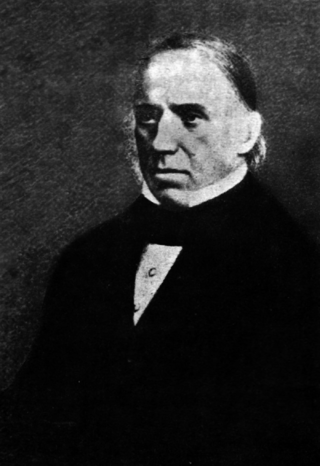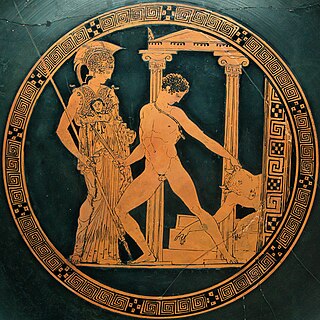

In Gaelic mythology, Brian (or Uar) was one of the three Sons of Tuireann along with Iuchar and Iucharba.


In Gaelic mythology, Brian (or Uar) was one of the three Sons of Tuireann along with Iuchar and Iucharba.
In many extant institutionally-held manuscripts of the Oidheadh Chlainne Tuireann, Brian is actually called Uar (or Uair [1] ), but the name has been emended by editors to "Brian" which conforms with the name in ancient texts. [a] [2] Eugene O'Curry was working from a manuscript in his possession, [3] and gives the name as "Brian", but notes that "Uar" was an alternate name for Brian. [4]
In Oidheadh Chlainne Tuireann (The Tragedy of the Sons of Tuireann), the three set out to kill their father's enemy Cian. Cian is the father of Lugh, one of the greatest of the Tuatha Dé Danann. Cian shapeshifts into a pig to disguise himself, but the brothers shapeshift into dogs and hound him. They kill him, dismember his body and try to cover up their crime. In recompense, Lugh makes them quest all around the known world fetching magical weapons, which Lugh plans to use at the Second Battle of Magh Tuireadh. They succeed in obtaining all that Lugh demanded, but return to Ireland badly wounded, pleading for Lugh to heal them; but he refuses.
In at least one version of this tale, Brian is the clever and subtle one, while his brothers Iuchar and Iucharba are bumbling and easily overawed by Brian. This tale of the Sons of Tuireann has sometimes been likened to an Irish Argonautica . [5]

Lugh or Lug is a figure in Irish mythology. A member of the Tuatha Dé Danann, a group of supernatural beings, Lugh is portrayed as a warrior, a king, a master craftsman and a saviour. He is associated with skill and mastery in multiple disciplines, including the arts. Lugh also has associations with oaths, truth, and the law, and therefore with rightful kingship. Lugh is linked with the harvest festival of Lughnasadh, which bears his name. His most common epithets are Lámfada and Samildánach. This has sometimes been anglicised as "Lew of the Long Hand".

Manannán or Manann, also known as Manannán mac Lir, is a sea god, warrior, and king of the otherworld in Gaelic mythology who is one of the Tuatha Dé Danann.
In Irish mythology, Balor or Balar was a leader of the Fomorians, a group of malevolent supernatural beings, and considered the most formidable. He is often described as a giant with a large eye that wreaks destruction when opened. Balor takes part in the Battle of Mag Tuired, and is primarily known from the tale in which he is killed by his grandson Lugh of the Tuatha Dé Danann. He has been interpreted as a personification of the scorching sun, and has also been likened to figures from other mythologies, such as the Welsh Ysbaddaden and the Greek Cyclops.
In Irish mythology, Caitlín was the wife of Balor of the Fomorians and, by him, the mother of Ethniu. She was also a prophetess and warned Balor of his impending defeat by the Tuatha Dé Danann in the second battle of Magh Tuiredh. During that battle she wounded the Dagda with a projectile weapon. She was also known by the nickname Cethlenn of the Crooked Teeth.
In Irish mythology, Tuireann was the father by Danu of Creidhne, Luchtaine, and Goibniu.
In Irish mythology, Dian Cécht was the god of healing, the healer for the Tuatha Dé Danann, and son of the Dagda according to the Dindsenchas.
The Enbarr (Énbarr) or Aonbharr of Manannán is a horse in the Irish Mythological Cycle which could traverse both land and sea, and was swifter than wind-speed.

In Irish mythology, Ethniu in modern spelling, is the daughter of the Fomorian leader Balor, and the mother of Lugh. She is also referred to as Ethliu.
In the Mythological Cycle of early Irish literature, the four treasures of the Tuatha Dé Danann are four magical items which the mythological Tuatha Dé Danann are supposed to have brought with them from the four island cities Murias, Falias, Gorias, and Findias when they arrived in Ireland.

The Mythological Cycle is a conventional grouping within Irish mythology. It consists of tales and poems about the god-like Tuatha Dé Danann, who are based on Ireland's pagan deities, and other mythical races such as the Fomorians and the Fir Bolg. It is one of the four main story 'cycles' of early Irish myth and legend, along with the Ulster Cycle, the Fianna Cycle and the Cycles of the Kings. The name "Mythological Cycle" seems to have gained currency with Arbois de Jubainville c. 1881–1883. James MacKillop says the term is now "somewhat awkward", and John T. Koch notes it is "potentially misleading, in that the narratives in question represent only a small part of extant Irish mythology". He prefers T Ó Cathasaigh's name, Cycle of the Gods. Important works in the cycle are the Lebor Gabála Érenn, the Cath Maige Tuired, the Aided Chlainne Lir and Tochmarc Étaíne.

Eugene O'Curry was an Irish philologist and antiquary.

The Children of Lir is a legend from Irish mythology. It is a tale from the post-Christianisation period that mixes magical elements such as druidic wands and spells with a Christian message of Christian faith bringing freedom from suffering.
In Irish mythology, Mesgegra was king of Leinster during the events of the Ulster Cycle, and was also the brother of Mac Da Thó aka Mes Róidia in The Tale of Mac Da Thó's Pig.

The golden apple is an element that appears in various national and ethnic folk legends or fairy tales. Recurring themes depict a hero retrieving the golden apples hidden or stolen by a monstrous antagonist. Gold apples also appear on the Silver Branch of the Otherworld in Irish mythology.
In the Ulster Cycle of early Irish literature, the Lúin of Celtchar is the name of a long, fiery lance or spear belonging to Celtchar mac Uthechar and wielded by other heroes, such as Dubthach, Mac Cécht and Fedlimid.

In Celtic mythology, Ecne was one of the Tuatha Dé Danann and was the god of wisdom, or knowledge.
Maelsuthan Ua Cerbhail, Maelsuthain O'Carroll, or Maelsuthain O'Cearbhail was a political and academic figure in medieval Ireland. He was lord of the Eóganacht Locha Léin, advisor to High King Brian Boru, and an important scholar often credited for beginning the Annals of Innisfallen. Maelsuthan's academic reputation was considerable, earning him accolades like "chief doctor of the Western world in his time" and "sage of Ireland."
In Irish mythology, Cian or Cían, nicknamed Scal Balb, was the son of Dian Cecht, the physician of the Tuatha Dé Danann, and best known as the father of Lugh Lamhfada. Cían's brothers were Cu, Cethen, and Miach.
Failinis [FAW IHN-ish] or Ṡalinnis/Shalinnis is a dog in the Mythological Cycle of Irish literature, belonging to Lugh Lámhfhada of the Tuatha Dé Danann; it was one of the eric (reparation) items exacted from the sons of Tuireann.

Glas Gaibhnenn, in Irish folklore, is a prized fabulous cow of bounty (fertility) that yields profuse quantities of milk.